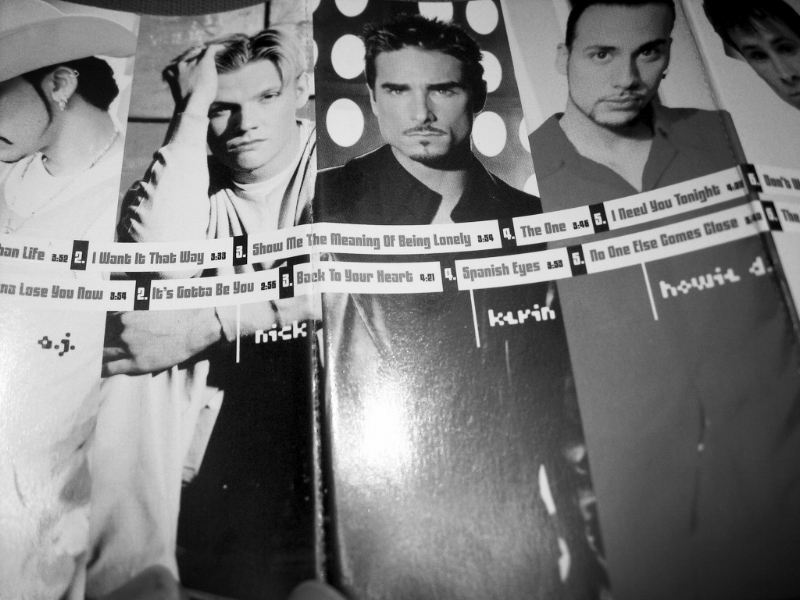Deceptive cadence precedes a dramatic whole-step modulation.
The mere mention of boy bands makes me feel like a scoffing teenager. I tried to be as much of a rebel as I could in high school. Sure, I was in the marching band (duh) and an honors student, but I dressed super weird & was also an active member in the Students' Rights Forum. The primary manner in which I attempted to distinguish myself, however, was through my musical taste. As pure pop crept back to cultural relevancy in the late 90s, I rejected it outright. Of course, unbeknownst to me, I was just buying into another marketable sect, but I righteously felt that my plaid pants and obsessions with third wave ska & The Smashing Pumpkins set me apart. I left my friends in the dust and I didn't fall for boy bands.
I did accidentally meet 'NSync while on assignment for the local metro paper (which I wrote for as a teen) in 1999. That was particularly hilarious because I was on assignment with my absolute goth-iest friend, and it was us, not the school cheerleaders, who got Justin Timberlake's signature. We were hilariously starstruck but we laughed it off as ironic starstruck and listened to The Cure all the way home.
And then later that spring, this song came along. I remember very clearly seeing BSB perform this song on SNL. I hated to admit it, hated it so much, but I loved this song. And I still do. It's become a generational hallmark. Beyond that, it's a masterclass in songwriting economics & effectiveness.
Intro: Boy bands dominated radio airwaves in the late 1990s, and by the numbers, the Backstreet Boys are the most significant boy band of all time, having sold a total of 130 million records. Millennium, the album on which this song appears, has sold over 13 million copies, and is considered the fourth biggest selling album of the SoundScan era. Although Millennium spawned four singles, "I Want It That Way" was the lead single and considered the group's signature song. It was nominated for a Grammy for Record of the Year in 2000 (losing to Santana's "Smooth") and topped singles charts in 25 countries without topping the Billboard Hot 100 Chart (it topped the Adult Contemporary Chart and Top 40 Chart instead).
Spoiler Alert: There is a wicked deceptive cadence at the end of the first chorus and a key change before the third repetition of the chorus.
Analysis: Using a fairly common chord progression throughout the verses (vi-IV-I or vi-V-I), the modulation in this song is less common. In many pop ballads, the key change would be a simple half step up -- direct modulation, also known as the "gear shift" or "truck driver" modulation. Here instead, the song moves up a whole step via a diatonic pivot chord. Although it begins on a vi chord (here F# minor), and the outline of said vi chord is heard in melodic material throughout the song (on the first "You are my" and then the "I want it", as well as many other instances), the song is in A major and experiences a IV-I cadence almost every line of the verses. There is a change before the bridge section, where a chromatic mediant (III) chord suddenly appears (at 1:51 in the video recording), essentially making for a somewhat jarring deceptive cadence (vi-III) at the end of the second chorus. Despite this, the bridge does not modulate (using a vi-I-IV-ii-V chord progression instead). Instrumentation thins out after the bridge, and the original key & melodic material is explored again until one more outline of the vi chord. At 2:30 in the video recording seen above, the E chord pivots & changes function, moving from a V chord (in the original A major) to a IV chord (in the new B major). It should be noted that the E chord heard at 2:30 is an Esus4, and changes back to a basic E chord at 2:32. After the dramatic key change up a whole step, the song remains in the newly established B major for the remainder of the song with a series of chord progressions of IV-V-vi / IV-V-vi / IV-V-I / vi-V-I.
Considerations for Teaching: While the Backstreet Boys have faded in popularity since their late 90s heyday, this songs appears to be an undying classic. There are no offensive lyrics to be found in this song, and with its effectively timed key change, it would make an excellent teaching tool.
Artist Note: BSB member Nick Carter has been accused of sexual assault.


